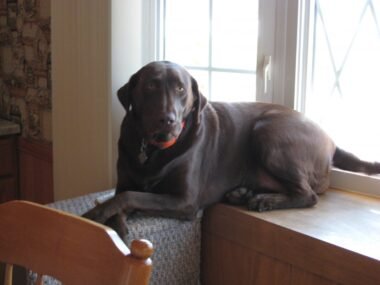Medical Reasons Why Your Dog Backs Away From Food
There are a few possible medical reasons why your dog may back away from their food bowl.
• Nausea or upset stomach. If your dog isn’t feeling well, the last thing they want is food. Watch for other signs like vomiting, diarrhea or lethargy. You may need to take your dog to the vet, especially if symptoms persist for more than a day.
• Dental pain. Does your dog have a tooth infection, broken tooth or other mouth injury? Eating may cause pain or discomfort. Gently inspect your dog’s teeth and gums for any redness or swelling. Again, a vet visit is a good idea if you notice anything concerning.
• Food allergy or intolerance. If a new food or treat doesn’t agree with your dog, they may avoid eating. Think back to any recent diet changes. An elimination diet under the guidance of your vet can help determine if a food allergy is to blame.
• Anxiety or stress. Sometimes a dog will walk away from their food due to anxiety over noises, lack of routine or other stressors. Try to minimize disturbances and stick to a regular feeding schedule. If anxiety seems severe or ongoing, talk to your vet about treatment options to help your dog feel more at ease.
READ ALSO: A Review of Entrust Dog Food

Anxiety or Fear Around the Food Bowl
Your dog pushing their food bowl away or backing away from it could be a sign of anxiety or fear. Some possible reasons for this behavior:
- Negative association. Something scary or unpleasant happened to your dog in the area where they eat, and now they associate that spot with the bad experience. The solution is to move the food bowl to a new location and make mealtimes positive with praise, treats and play.
- Noise sensitivity. Loud noises from appliances, kids playing or outside traffic could startle your dog while they’re eating. Try feeding them in a quiet, isolated area away from the activity.
- Separation anxiety. Your dog may have become anxious over being left alone, and the food bowl area triggers that anxiety because that’s where you leave them when you go out. Give them interactive dog toys stuffed with peanut butter or treats to help ease their anxiety, and never punish them for being anxious.
- Medical issue. In some cases, a medical problem like gastrointestinal upset or pain could make your dog unwilling to eat. If their behavior seems unusual or lasts more than a couple days, it’s best to have your vet examine them to rule out any medical causes.
READ ALSO: Value Pak Dog Food
Reasons Why Dog Backs Away From Food
1. Boredom With the Same Food Every Day
Your dog may be backing away from their food bowl simply due to boredom with eating the same dog food every day.
Mixing up their meals with different flavors, textures and toppings is an easy fix. You can:
- Add a splash of low-sodium broth to their kibble. The smell will peak their interest and make the food more appetizing.
- Top it off with some cooked meat like chicken, fish or eggs. The extra protein is a treat and gives them something to look forward to.
- Switch between wet and dry food. If you usually feed only dry kibble, add in some wet food a few times a week. The gravy and chunks will make mealtime more exciting.
- Talk to your vet about rotating between a few different dog food brands or recipes.
Using a variety of flavors, textures and puzzle toys to keep your dog engaged at meal times should get them eagerly awaiting each bowl of food again. While consistency is important, injecting some novelty and fun into their feeding routine will prevent boredom and keep them interested in chowing down. With patience and creativity, you can get your pup excited for every bite!
2. Prefers Eating in Another Location
Your dog may prefer eating in another location simply due to habit or positive association with a different area. Many dogs develop a habit of eating in the same spot for each meal. If their food bowl is moved to a new area, it may seem unfamiliar or strange to them at first.
Give your dog some time to get used to the new location of their food bowl. You can also try making the new area extra inviting by:
- Placing their food bowl near a window so they can look outside. Many dogs enjoy watching outside while they eat.
- Giving your dog a puzzle toy with treats or peanut butter to help them associate the new area with positive experiences.
- Feeding your dog in the new spot a few times while giving them praise, treats and belly rubs. This helps them link the location to rewards and good feelings.
- Keeping mealtimes relaxed and low stress. Avoid hovering over your dog while they eat in the new area. Give them space to eat at their own pace.
- Placing a rug, mat or blanket under the food bowl. The familiar texture may make the new spot seem more normal and cozy for mealtimes.
3. Needs More Exercise or Mental Stimulation
If your dog seems disinterested in their food bowl, it could be a sign they need more exercise or mental stimulation. Dogs are intelligent animals and get bored easily without opportunities to challenge their mind and body.
Keeping your dog well-exercised, mentally engaged and socially stimulated will improve their appetite and make meal times an enjoyable part of their daily routine. Be patient through the transition, as it can take time and consistency. But with your support and interaction, your dog will come to view their food bowl as a source of nourishment for both their body and mind.
Conclusion
If after a week or so of trying these techniques your dog is still hesitating or backing away from their food in the new location, you may need to consider other reasons for their behavior or consult with your vet.
With time and consistency, your dog should become perfectly comfortable eating in the spot you have chosen for their meals. Be patient through the transition and make it a positive experience for your furry friend.





